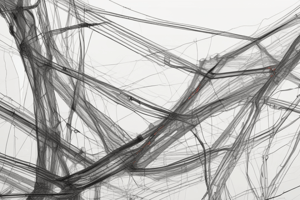Podcast
Questions and Answers
Which topic is discussed in section 30.17.3?
Which topic is discussed in section 30.17.3?
- Minimum spanning tree
- Directed graph components
- Practice
- Topological sort (correct)
What is the main focus of section 30.20.4?
What is the main focus of section 30.20.4?
- Levenshtein distance (correct)
- Dot product
- Up and down
- Jousting
In which section do we find information about 'Undirected graph components'?
In which section do we find information about 'Undirected graph components'?
- 30.15.1
- 30.17.1 (correct)
- 30.19.2
- 30.18.1
What is the main focus of section 30.16.5?
What is the main focus of section 30.16.5?
Which topic is covered in section 30.19.3?
Which topic is covered in section 30.19.3?
Where can you find information about 'Tractable and intractable problems'?
Where can you find information about 'Tractable and intractable problems'?
What is a common way to represent a graph using an array where each element corresponds to a vertex and stores the vertices adjacent to it?
What is a common way to represent a graph using an array where each element corresponds to a vertex and stores the vertices adjacent to it?
Which of the following is NOT a basic concept related to graphs?
Which of the following is NOT a basic concept related to graphs?
What algorithmic problem does 'Minimum Spanning Tree' aim to solve in graph theory?
What algorithmic problem does 'Minimum Spanning Tree' aim to solve in graph theory?
In graph theory, what does 'Topological Sort' help to determine for directed acyclic graphs?
In graph theory, what does 'Topological Sort' help to determine for directed acyclic graphs?
Which type of graph traversal visits all neighbors of a vertex before moving on to the next level?
Which type of graph traversal visits all neighbors of a vertex before moving on to the next level?
What is the purpose of 'Modelling with graphs' in Computer Science?
What is the purpose of 'Modelling with graphs' in Computer Science?
Which topic in the text covers modeling with graphs and different representations?
Which topic in the text covers modeling with graphs and different representations?
What is an example of a rooted tree discussed in the text?
What is an example of a rooted tree discussed in the text?
In the context of graphs, what does breadth-first search focus on?
In the context of graphs, what does breadth-first search focus on?
What does the text discuss regarding algorithms on trees?
What does the text discuss regarding algorithms on trees?
Which sorting technique is NOT discussed in the context of rooted trees?
Which sorting technique is NOT discussed in the context of rooted trees?
What is a common application of greedy algorithms discussed in the text?
What is a common application of greedy algorithms discussed in the text?
Flashcards are hidden until you start studying
Study Notes
Interval Scheduling
- Greedy approach is used to solve interval scheduling problems
- Greedy choices are made to optimize the overall solution
Graphs
- Modelling with graphs involves representing real-world problems using graphs
- Basic concepts include nodes, edges, and graph types (directed/undirected)
- Graphs can be represented using edge lists, adjacency matrices, or adjacency lists
- Graph classes can be implemented in Python using DiGraph and UndirectedGraph classes
Tree Data Structures
- Binary trees have a maximum of two children per node
- Algorithms on trees include divide and conquer, and arm's-length recursion
- Tree traversals include depth-first search, pre-order, in-order, and post-order traversal
- Binary search trees (BSTs) allow for efficient search, insertion, and deletion operations
- Heaps are a type of binary tree that can be used for efficient sorting (heapsort)
Shortest Paths
- Shortest paths can be found using algorithms such as Dijkstra's or Bellman-Ford
- Shortest paths have applications in networking, traffic routing, and more
Greed
- Greed is an algorithmic paradigm that involves making locally optimal choices
- Greed is used to solve problems such as interval scheduling, minimum spanning tree, and shortest paths
Dynamic Programming
- Dynamic programming is an algorithmic paradigm that involves breaking down problems into smaller subproblems
- Dynamic programming is used to solve problems such as longest common subsequence, knapsack, and travelling salesman
Backtracking
- Backtracking is an algorithmic paradigm that involves recursively exploring possible solutions
- Backtracking is used to solve problems such as the travelling salesman problem and knapsack
Sorting
- Sorting algorithms include insertion sort, selection sort, merge sort, and quicksort
- Each algorithm has its own time and space complexity, as well as performance characteristics
Recursion
- Recursion is a programming technique that involves defining a function in terms of itself
- Recursion is used to solve problems such as the factorial function, and searching permutations and subsets
Divide and Conquer
- Divide and conquer is an algorithmic paradigm that involves breaking down problems into smaller subproblems
- Divide and conquer is used to solve problems such as binary search, and merge sort
Complexity Classes
- Complexity classes are used to classify algorithms based on their time and space complexity
- Examples of complexity classes include P (tractable) and NP (intractable)
Studying That Suits You
Use AI to generate personalized quizzes and flashcards to suit your learning preferences.




